Research Article
Relationship Quality and Self-Silencing among Married Couples
6461
Views & Citations5461
Likes & Shares
Martin Luther said “There is no more lovely, friendly and charming relationship, communion or company than a good marriage”. Marriage and family, are the two social situations with biological foundation, and are complementary to each other. There are several factors that wound the soul of the marriage. Childlessness amongst couples, a growing trend in the world is now prevalent in India, a country in which motherhood is glorified. What we do not know is what the family formations of these individuals look like, and how they might contribute to shifting configurations of family. The present study aims at finding the level of Relationship Quality and Self-Silencing among Couples with children and without children. The participants of the study include 30 Childless and 30 Parental couples. Purposive sampling method was employed for the collection of data. The participants were administered using Relationship Quality scale developed by Jill M Chonody, and the Silencing the self-scale questionnaire developed by Jack D C Obtained results were analyzed using Two-way ANOVA and Karl Pearson’s Correlation Method. The result indicates that there is significant gender difference in the Relationship Quality among couples with and without children, and there is significant gender difference in the level of Self-Silencing among couples with and without children and also the study reveals that there is a significant relationship between Relationship Quality and Self-silencing.
Keywords: Relationship Quality, Self-silencing
INTRODUCTION
“What it’s like to be a parent: It’s one of the hardest things you’ll ever do, but in exchange.it teaches you the meaning of unconditional love.”-Nicholas Sparks Martin Luther said “There is no more lovely, friendly and charming relationship, communion or company than a good marriage”. Marriage and family, the two social situations with biological foundation, are complementary to each other. Both do have a long-standing history. On the other hand, marriage is known as legal union of male and female. It can also define as the process through which two people who each other or those totally different backgrounds are bonded and make their relationship public, official and permanent. Some factors which influencing marital life is adjustment, satisfaction, trust, intimacy, respect etc. To keep a marriage alive, couples must sustain moderate levels intimacy, communication and spend time with each other which make successful one. It is said that, Marriages are made in heaven and celebrated on earth in other words, other words, "marriages are made in heaven but the maintenance is done on earth" well both are very true in their own essence. There is a huge transition when one gets married, the whole life changes, everything changes, from being a single person, here no more life of one after marriage, everything is always for two and after few years more than two. As one gets married, we start a whole new family, a complete shift from individualism. One gets lots of responsibilities to fulfil as one enter into marital life. Happily married couples generally are not as much concerned about aging as unmarried people do. People in happy relationships look out for their partners love and care for them, even if they don’t remain as attractive as they once were. Their relationship bond is strong and their physical appearance makes a little difference. Therefore, aging is not something that happily married couples stick upon. Both men and women who are happily married show signs of better general health than those who are not married, or are widowed or divorced. This can be due to a many reason, such as being more deliberate with diet and exercise, and holding one another is also a considerable fact.
Also, a spouse can notice if one is not themself or not feeling well and get you to the doctor for a timely check-up, thus preventing health issues from becoming more serious. In a thriving marriage, partners look out for each other and help each other to stay healthy physically. Marriage is something more than a physical union; it is also called a spiritual and emotional union. When a man and woman get married, from then the “two become one. There is nothing as „perfect couple‟ or a „perfect partner‟. There will be ebbs and flows in every marriage. In every marital life everyone has to give up or adjust with one or another thing for a successful marriage life. There are several factors that wound the soul of the marriage. In a relationship people show some sort of social, emotional and physical dependency on the other person. This is simply the degree of contentment regarding certain aspects of marital relationship as well as the whole relationship. Love/Commitment. At its core, love is a decision to be committed to another person, Sexual Faithfulness, Humility, Patience/Forgiveness, Time, Honesty and Trust, Communication, Selflessness.
Childlessness is most commonly seen within developed nations and that it may be more common among the most economically privileged. What we do not know is what the family formations of these individuals look like, and how they might contribute to shifting configurations of family. In fact, the will to take care of intimacy with one’s partner is among the foremost commonly cited reasons that the voluntarily childless choose to not bear or rear children. The transition to parenthood is a period of stress for many couples. Many studies handlings transition to parenthood identified changes within the marriage that occur when children enter their relationship. Parenthood constitutes a crucial stage within the Psychosexual and social development of the many women and men, creating the likelihood to execute variety of life goals and to fulfil certain needs.
It has been said that children are the ones who make a marriage. However, the meaning of this statement would wish to be elucidated before its truth might be tested. If it's taken to mean no quite that children help to bind the couple together, then the statistics of divorce would have something to contribute if only they were less ambiguous.
So, this research is mainly to respond to the criticism by consolidating what we do know about family forms and relationship about married couples who are parents and also who did not experience a parenthood or are childless right now.
Relationship quality of married couples
The present study focuses on couples who had been married for 5 years and among those are parents and also who remain childless. The relationship quality of married couples is reported consistently high average. For most parents, the birth of a child brings joy and happiness, and parenthood brings many rewards, such as affection, a sense of achievement, the fulfilment of reproductive needs and social expectations, and relationship stability [1]. At the same time, it requires adjustment to the new role as a parent and to having a baby that demands their constant care and attention. Coping with crying, the physical demands of breastfeeding, and disturbed sleep add to the challenges that couples face when they become parents [1]. Babies and young children demand time and energy that parents can no longer spend together or by themselves. New parents, and mothers in particular, thus face a drastic change in their time schedule, spending much more time on family work than before childbirth [2] and spending less time on leisure and activities together with their partner [3]. In fact, most of the leisure time that partners have together is spent with the baby [4]. Accordingly, the focus of attention and energy at home largely shifts from the partner and the self to the baby, and this can have an adverse effect on the marital relationship. Bell and Vogel 1960 were especially interested in the child’s role as a scapegoat in maintaining the family equilibrium. Parents who had underlying conflicts in reference to one another, and who by using a child as the object for displacement of their hostility, were able to develop an equilibrium in which they minimized conflict with each other and thus made it possible to measure with one another. But this equilibrium was achieved at tremendous cost to the personality development of the child designated as the scape goat. This child becomes the object of family hostility, is devalued as an individual, and is blamed for all family misfortune. The question “why does one need a child” was presented as an open question to the childless women and their partners. The foremost frequent spontaneous answer was “it’s just a feeling”.
Self-silencing in married couples
In order to lead a marital life smoothly both the partners should understand each other. Partner’s drawbacks, positive, interests, likes, dislikes etc. The term self-silencing refers to what's initially a lively process of withholding emotion, strength, capabilities and opinions seemed to be threatening to one’s partner so as to take care of their relationship [5]. The partners with open mindedness will have low self-silencing and relationship quality will be high. According to Jack, self-silencing occurs when a person suppresses his or her true thoughts, beliefs and desire. It is related to “no voice, authenticity in relationship, and false self” [5]. The term self-silencing and “loss of voice” have been used in very similar ways, but with different populations. “False self” and “disingenuous” ask differences between what one expresses to others and what one actually thinks and feels [6]. They encompass self-silencing because self-silencing is a behavior that means one is exhibiting a false self or acting in authentically by suppressing thoughts, beliefs, or desires. This loss of voice coincides with the loss of one’s unique sense of self, the manipulation of one’s identity into someone more socially and culturally acceptable and lack of trust in one’s personal opinion as accurate. Silencing the self is not limited to one’s voices. It refers to self - silencing the thoughts as well. Forcing oneself to stop thinking, judging one’s own thoughts, and silencing one’s voices and opinions are the methods by which self-silencers keep themselves from expressing anger and resentment. It is believed that failure to express feeling such as anger, resentment contributes to depression. Jack and Dill [5] explicitly identify self-silencing as a selected, cognitive schema, derived from culture”, and not as a personality trait. As such, the silencing the self-theory is based primarily on the phenomenological relationships rather than a personality model of stable, universal attributes. Self-silencing differs from other examples of relational compromising such as accommodation and willingness to sacrifice [7]. In a relational compromising perspective self-silencing behavior are considered to be a consistent way of interaction with an intimate partner. While the act of self-silencing may appear on the surface, to be constructive in one particular situation and it is more likely that, the persistent suppression is a destructive response either to the individual or to the relationship. Self-silencing can also be illustrated as an active process of censoring one’s thoughts, ideas and opinions especially when those ideas may conflict with an intimate partner, often as a way of attempting to maintain an intimate relationship [5]. It may lead to a devaluating of one’s emotions and experiences over time, as one continually puts one’s partner’s desires first. Self-silencing is distinct from personality traits because self-silencing can fluctuate consistent with current relationship outcomes and issues, there are numerous studies that indicates that self-silencing is linked clearly with dispositional traits associated with vulnerability to depression. Moreover, there is some evidence pointing out those self-silencing acts as a mediator or moderator in the association between personality and depression. According to Jack and Dill [5] one way of interpreting the meditational results is that self-silencing is one of the highly maladaptive responses of vulnerable individuals who are clearly very high in interpersonal sensitivity and responsiveness to negative interpersonal interactions and associated stressors [5].
RATIONALE OF THE STUDY
Leigh Weingus wrote, “Having kids was considered a necessity for women, but the last few years have showing shifting trends surrounding settling down” Childlessness amongst couples, a growing trend in the world is now prevalent in India, a country in which motherhood is glorified. There are people who considers being parents as an option and also who categorically refuse the role, but in midlife they are uncomfortable with the decision they made and feel that was not the right choice. So, the researcher wants to know the importance of children to maintain a harmony in the couple’s relationship. High self-silencers reported conceding more to their partner during a conflict, poorer global communication within their romantic relationship.so, the researcher would also like to know whether these vary in couples with children and without children.
REVIEW OF LITERATURE
The objective of the study is largely to draw attention to the role of children in parent’s Relationship quality and Self-silencing.it is necessary first to review the literature pertinent in these fields. This chapter includes an overview of the researches done in relation to Relationship quality, and Self-silencing among married couples. It will give an idea about the plausible link between children and couple relationship and other variable that has a considerable influence on couple relationship.
Studies related to relationship quality among couples
Williams & Parra 2019 studied on the longitudinal and bidirectional association between parenting stress and couples’ relationship quality. This study examined the longitudinal and bidirectional association between parenting stress and relationship quality, and whether the associations differed between married and cohabiting couples, using cross-lagged panel models (CLPM) and random-intercept cross-lagged panel models (RI-CLPM). Using data from the Fragile Families and Child Well-being Study, the findings indicated that the RICLPM model provided a better fit to the data compared to the CLPM model for mothers and fathers. The RI-CLPM results showed high levels of stability in parenting stress and relationship quality over time, that parenting stress was associated with higher levels of relationship quality for both parents, and that the between- person effect was similar for married and cohabiting couples. This study highlighted the importance of accounting for between- and within-person variability.
Brown [8] studied on Relationship Quality Among Cohabiting Versus Married Couples. Using data from the nationally representative 2010 Married and Cohabiting Couples Survey of different-sex cohabiting and married couples we found that the relationship between union type and relationship quality is now bifurcated with direct marrieds reporting the highest relationship quality and cohabitors without marriage plans reporting the lowest marital quality. In the middle were the two largest groups: marrieds who premaritally cohabited and cohabiters with plans to marry. These two groups did not differ in terms of relationship quality. This study adds to the growing literature indicating that the role of cohabitation in the family life course is changing in the contemporary context.
Roy [9] studied Relationship Quality among Young Couples from an Economic and Gender Perspective. Less than a third of married couple households in the United States are composed of families with one breadwinner. The goal of this study was to determine how the perception of household chores is related to relationship quality. Specifically, we wanted to determine how perception of household chores is related to relationship quality reported by partners from a traditional economic and a gender role theory perspective results indicate that perceived unfairness in household division of chores was predictive of women’s relationship quality, but not men. Arguments about affection and money were predictive of relationship quality for both genders.
Rijkena [10] conducted a study which examines the influence of partner relationship quality on childbearing. We also pose a new hypothesis on the direction of the effect of relationship quality on fertility, predicting that medium levels of relationship quality result in the highest childbearing rates. Results indicate that only women’s perceptions of relationship quality influence a first birth, whereas women’s and men’s perceptions affect second births. We do not find unique effects of disagreement in assessments of relationship quality; effects of partners’ perceptions are additive. Women reporting medium levels of relationship quality are most likely to have another child, whereas men with medium and high-quality relationship.
Harper [11] studied on the topic keeping quiet: Self-silencing and its association with relational and individual functioning among adolescent romantic couples. This study examined the relationships between self-silencing and relational and individual functioning among adolescent romantic couples. High self-silencers reported conceding more to their partner during a conflict, poorer global communication within their romantic relationships, and greater experiences of depressive symptomatology. Partners of self-silencers reported more frustration and discomfort when interacting with the self-silencing member.
Whiffen [12] studied to examine whether Self-silencing mediates the link between marital conflict and depression. The present study investigated whether self-silencing mediates the relationship between marital conflict and depressive symptoms. Results indicated that both men and women who perceived their marriages as conflicted tended to hide their anger while pretending to go along with their partner's opinions or wishes which, along with a tendency to judge oneself by external standards, also mediated the relationship between marital conflict and depressive symptoms. The silencing model appears to describe the development of both men's and women's depression in conflicted marriages and may be refined by focusing on how individuals cope with anger in intimate relationships.
Harper [13] conducted a study which examined the link between rejection sensitivity, self-silencing behaviors, and depressive symptomatology among adolescent dating couples. Self-silencing was hypothesized to be the process mediating the association between rejection sensitivity and depressive symptoms. Results indicated that dating adolescents who were sensitive to rejection reported more depressive symptomatology and higher levels of self-silencing behaviors within their romantic relationship compared to dating adolescents who were not so sensitive to rejection. Self-silencing was identified as a partial mediator of the association between rejection sensitivity and depressive symptomatology among dating adolescents. Clinical implications in light of these findings are discussed.
Thompson [14] conducted a research on the topic Does Self-Silencing Link Perceptions of Care from Parents and Partners with Depressive Symptoms? In this study, we linked this theory to a substantial empirical literature indicating that adult depression is associated both with perceptions that parents were rejecting during childhood, and with perceptions that the current romantic partner is critical. The results indicated that, among women, only current romantic relationships were associated with self-silencing. Silencing also mediated the association between perceived spousal criticism and depressive symptoms. Partner as critical and intolerant. Among men, self-silencing was associated both with perceptions of the father as cold and rejecting, and with perceptions of the romantic between depressive symptoms and perceptions of the father and of the current romantic partner. Thus, our study supports the hypothesis that self-silencing is associated with the current interpersonal context in particular.
Jack [15] studied on Silencing the self: Inner dialogues and outer realities. To learn more about how social factors become internalized and affect depression, researchers need to listen carefully to women's inner dialogues and negative self-assessments. I offer a phenomenology of clinically depressed women's subjectivity, particularly focused on what their negative self- assessment reveals about underlying images of relatedness. Such images, and the dynamic of silencing the self, have been found to be reliably associated with depressive symptoms.
METHODS
This chapter consists of research questions, aim, objectives, research design, participants, sampling and sample selection criteria, procedure, tools and nature of the tools and the statistical analysis used in the study.
Research questions
- What is the level of Relationship quality and Self-silencing among couples with children and without children?
- Is there a significant gender difference in level of Relationship Quality and Self-silencing among couples with children and without children?
- Is there an interaction effect of gender and couples who are with and without children on Relationship Quality and Self-silencing?
- Is there a relationship between Relationship quality and Self-silencing among couples with children and without children?
Objectives
- To study the level of Relationship quality and self-silencing among couples with children and without children.
- To study the gender difference in the level of Relationship and self-silencing among couples with children and without children.
- To study the interaction effect of gender and couples who are with and without children on Relationship quality and Self-silencing.
- To study the relationship between Relationship quality and Self-silencing among couples with children and without children
Hypotheses
- H01 - There is no significant difference in level of Relationship quality among couples with children and without children.
- H02 -There is no significant gender difference in the level of Relationship quality among married couples.
- H03 - There is no interaction effect of gender and presence or absence of children on Relationship Quality among married couples.
- H04 -There is no significant difference in level of Self-silencing among couples with children and without children.
- H05- There is no significant gender difference in the level of self-silencing among married couples.
- H06 - There is no interaction effect of gender and presence or absence of children on Self-silencing among married couples.
- H07 -There is no significant relationship between Relationship quality, Resilience and Self- silencing among couples with and without children
VARIABLES
Independent variable
- Couples-Couples with children and without children
Gender-Male and Female Dependent Variable
- Relationship Quality
- Self-silencing
Sample
Purposive sampling method is used for the study. Total of 60 samples were considered from Kerala (Table 1).

Inclusion criteria
- Participants who are married and do not have children even after 5 years.
- Childfree couples.
Exclusion Criteria
- Couples who have adopted a child.
- Divorced, separated and widowed parents are excluded.
- Couples of age group above 50 years.
Research Design
- Research is Exploratory in nature and the Sample Survey Research Design is adopted.
Assessment Tools
- Personal Data Sheet: The personal datasheet was prepared by the researcher. The data sheet contains Socio-demographic details like Name, Age, year of Marriage, Number of children etc.
- Relationship Quality scale: RQ scale is a 9-item scale developed by Jill M. Chonody in 2016, Department of Social Work, Indiana University Northwest, and U.S.A. Relationship Quality (RQ) scale, designed to assess an individual’s perception of his or her RQ in their current partnership
Scoring key
- Items utilized a 5-point Liker type scale (1=strongly disagree and 5=strongly agree).
- A total RQ score was calculated by summing responses to the items which can range from 9-45.
Interpretation
Group norms were created on the basis of individual sample scores and interpreted accordingly (Table 2).
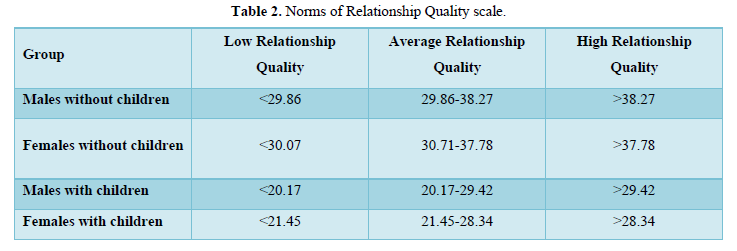

Reliability and Validity
High internal consistency reliability with a Cronbach’s alpha of .891. The scale indicated evidence of convergent construct validity with 0.787.
The Silencing the self-scale
The silencing the self-scale is a 31-item questionnaire developed by Dana.C. Jack in 2017.
Scoring
Each item is rated for agreement on a five-point scale, ranging from “strongly disagree “to “strongly agree”.
Here 5 of the items are reversed to control for acquiescence in response set (item 1, 8.11.15 and 21) with a possible range scores from 31 to 155.add the scores of each item, in order to get total raw score for the analysis, higher scores representing greater self-silencing.
Interpretation
Group norms were created on the basis of individual sample scores and interpreted accordingly (Table 3).


Reliability and Validity
The internal consistency reliability and Cronback’s Alpha obtained 0.88.
An index of the validity of the STSS was provided by its use as a measure in testing in testing two hypothesis relevant to the construct under the investigator.
Procedure
The purpose of the study was explained to the participants. The participant’s willingness to participate in the study was ascertained after the establishment of rapport. The socio-demographic details are collected. The participants were briefed about the three inventories separately and be provided with clear instructions. Then the scoring is done for the response obtained and interpretation will be made and results will be discussed.
Ethical issues
- The research has been approved by the department review committee.
- Written consent was obtained from the participants of the research.
- The participants were assured about the confidentiality of the information provided by them.
- The obtained data has been used only for the purpose of the research.
Statistical Analysis
- Two-way ANOVA
To find the level of Relationship and Self-silencing among couples with children and without children.
- Karl Pearson’s Product moment Correlation
To find the relationship between Relationship Quality and Self-silencing.
RESULT AND DISCUSSION
This chapter consists of the data relevant to the test hypotheses and interpretation of the results. the Two- Way Analysis of Variance was used to find out the significant difference amongst the groups and interaction effect between the variables.
Section 1: Socio Demographic data
The age of Without children couples indicates that 46% of female participants and 10% of male participants falls under the age range of 28-32, also 44% of female participants and 57% of male participants falls under age range of 32-36 and 10 % of female participants and 33% of male participants falls under the age range of 36-40 (Figure 1).
The age of couples with children indicates that 17% of female participants and 10% of male participants falls under the age range of 28-32, also 47% of female participants and 63% of male participants falls under age range of 32-36 and 36 % of female participants and 27% of male participants falls under the age range of 36-40 (Figure 2).
Part-Two Analysis
Main Variables: The level of Relationship Quality among Males without children indicates that 16.66% has low Relationship Quality, 6.66% has high Relationship Quality and 76.66% has average Relationship Quality (Figure 3).
The level of Relationship Quality among Females without children indicates that 20% has low Relationship Quality, 16.66% has high Relationship Quality and 63.33% has average Relationship Quality (Figure 4).
The level of Relationship Quality among Females without children indicates that 10% has low Relationship Quality, 30% has high Relationship Quality and 70% has average Relationship Quality (Figure 5).
The level of Relationship Quality among Females without children indicates that 20% has low Relationship Quality, 16.66% has high Relationship Quality and 63.33% has average Relationship Quality (Figure 6).
The level of Self-silencing among Females without children indicates that 6.66% has low Self- Silencing, 56.66% has high Self-silencing and 36.66% has average Self-silencing (Figure 7).
The level of Self-silencing among Females without children indicates that 10% has low Self- Silencing, 76.66 % has high Self-silencing and 13.33% has average Self-silencing (Figure 8).
The level of Self-silencing among Males with children indicates that 40% has low Self-Silencing, 3.33 % has high Self-silencing and 56.66% has average Self-silencing (Figure 9).
The level of Self-silencing among Females without children indicates that 56.66 has low Self- Silencing, 0% has high Self-silencing and 43.33% has average Self-silencing (Figure 10).
Part Three Analysis
Testing of hypothesis using Two- way Analysis of Variance
The hypothesis stating that there is no significant difference in the level of Relationship Quality among married couples with and without children was tested using Two- way Analysis of Variance
The obtained F value is 152.603 which is not significant at 0.05 level. Therefore H01, is accepted.
The hypothesis stating that is no significant gender difference in the level of Relationship Quality among married couples with and without children was tested using Two- way Analysis of Variance. The obtained F value is 0.001 which is significant at 0.05 level. Therefore, H02, is rejected.so there is a significance gender difference in level of Relationship Quality among married couples with and without children. Females without children and Males with children have high relationship quality. The present findings were supported by a study that the gender structure implies that men are quite dependent on a stable partner relationship in order to gain the full benefits of fatherhood, precisely because women are more likely to care for the children after separation. Hence, men have more to lose than women with respect to parenthood if the relationship dissolves [10].
The interaction effect of gender and presence or absence of children among married couples Relationship Quality was tested using Two- way Analysis of Variance. The obtained F value is 0.025 which is not significant at 0.05 level. Therefore, H03, is accepted (Tables 4 and 5 and Figure 11).
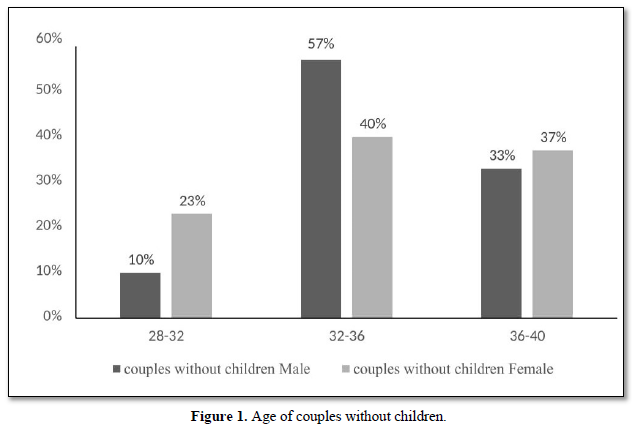
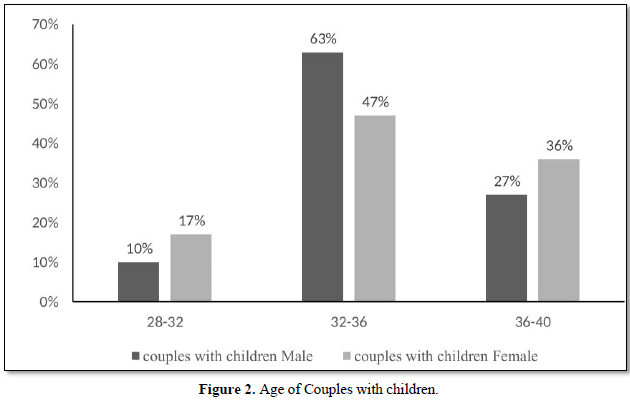
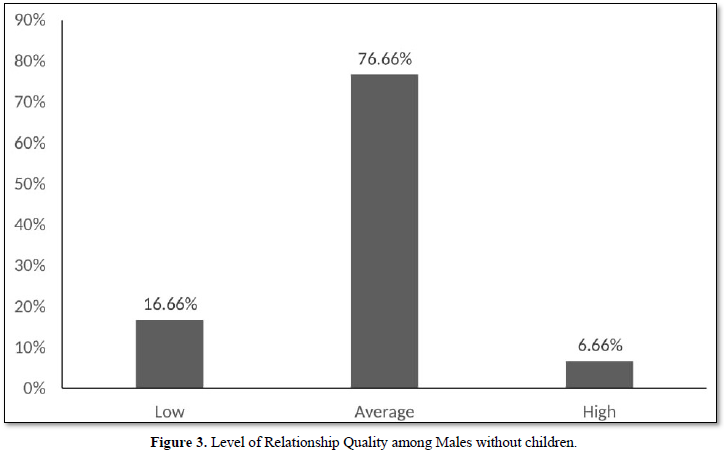
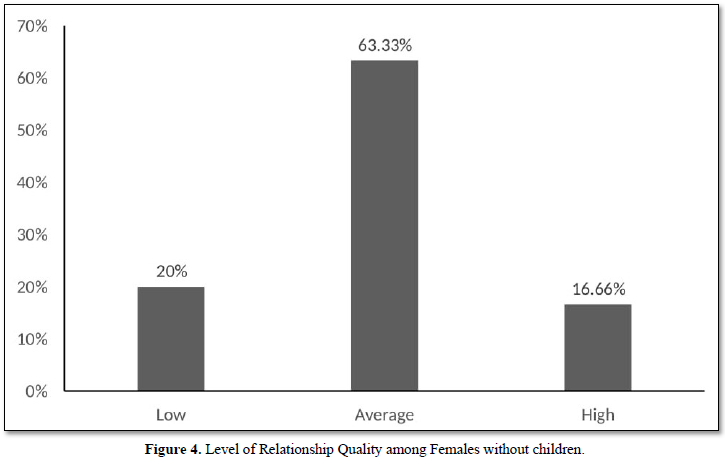
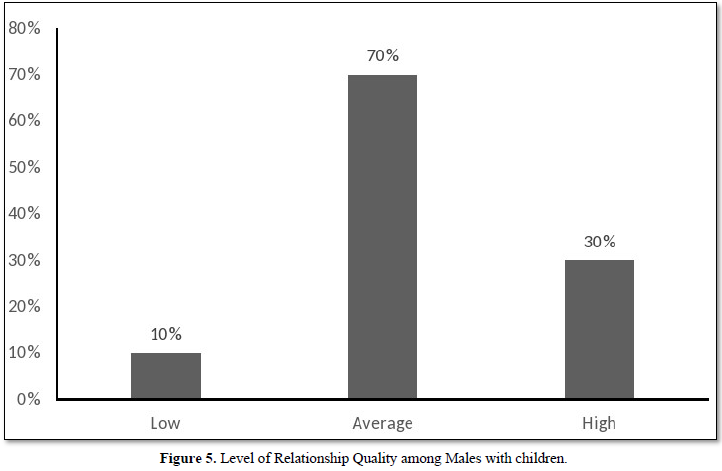
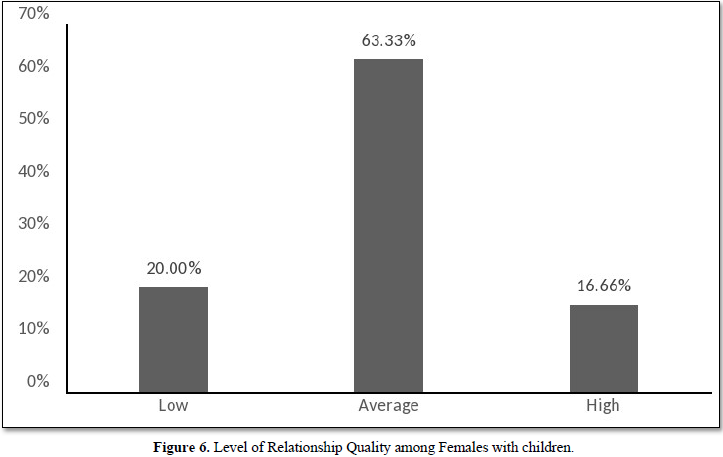
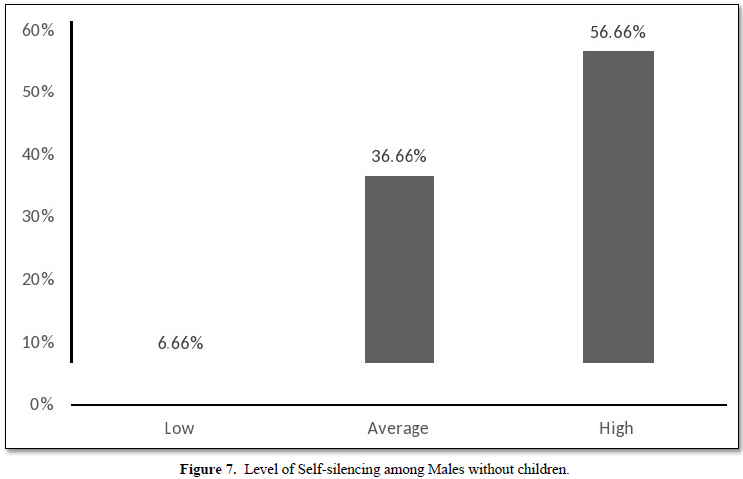
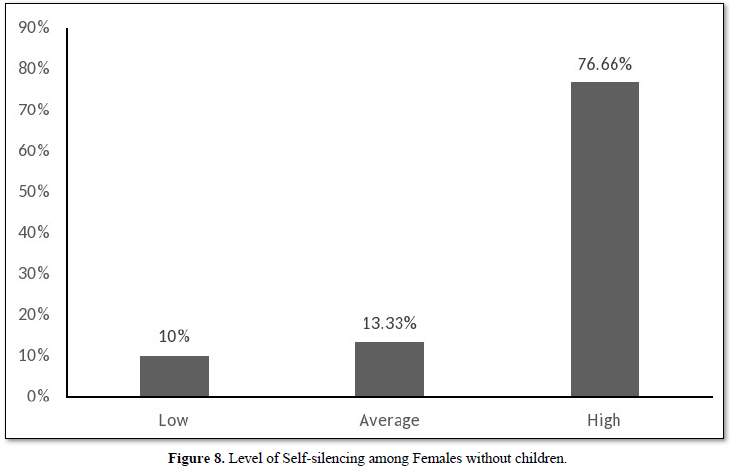
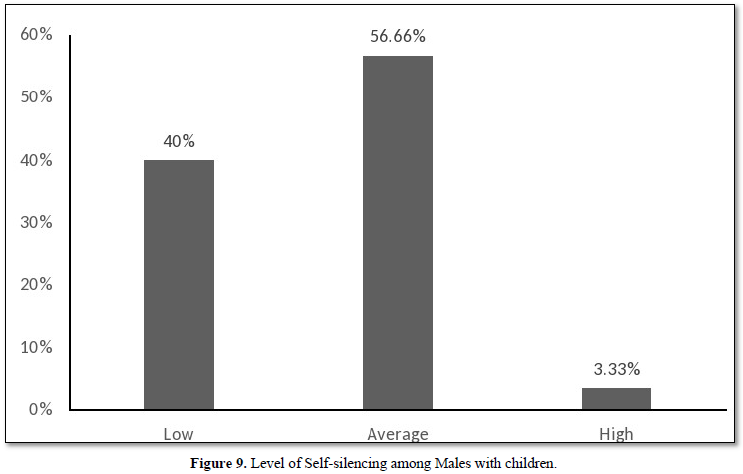


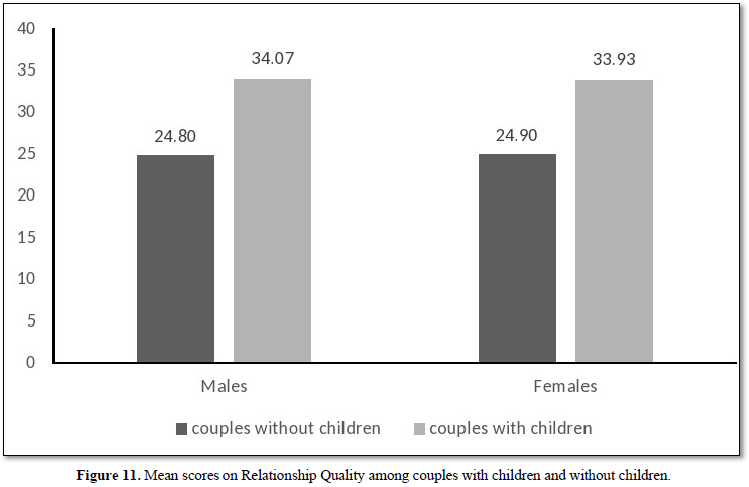
The hypothesis stating that there is no significant difference in the level of Self-silencing among married couples with and without children was tested using Two- way Analysis of Variance. The obtained F value is 36.619 which is not significant at 0.05 level. Thus, the obtained result indicates that there is no significant difference in the Self-Silencing among married couples with and without children Therefore, Ho4, is accepted.
The hypothesis stating that is no significant gender difference in the level of Self-silencing among married couples with and without children was tested using Two- way Analysis of Variance. The obtained F value is 0.337 which is significant at 0.05 level. Therefore Ho5, is rejected. Thus, the obtained result indicates that there is a significant gender difference in the level of Self-silencing among married couples with and without children. Females without children and Males with children has Self-silencing.
The hypothesis stating that is no interaction effect of gender and couples who are without children and with children on Self-Silencing was tested using Two- way Analysis of Variance. The obtained F value is 0.446 which is not significant at 0.05 level. Thus, the obtained result indicates that there is no significant interaction effect of gender and couples who are without children and with children on Self-silencing. Therefore, Ho6, is accepted (Tables 6 and 7 and Figure 12).


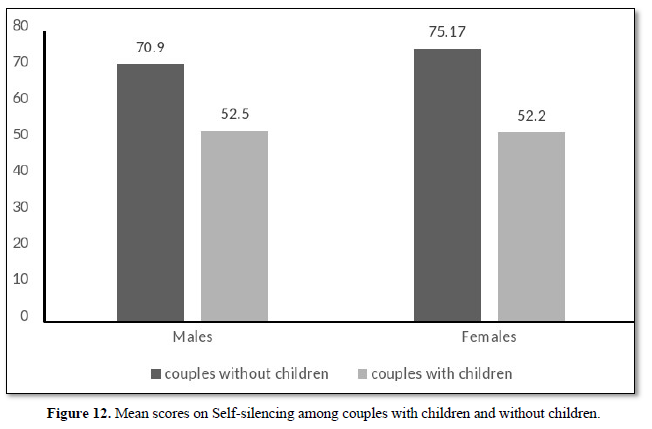
Karl Pearson’s Co-efficient of Correlation
The hypothesis stating that there is no significant relationship between relationship quality and Self-silencing obtained was tested using Karl Pearson’s coefficient of correlation, the result shows that r= -0.645**, which indicates the null hypothesis is rejected.so, there is a significant relationship between Relationship Quality and Self-silencing. The present findings were supported by a study which says when faced with conflict in their marriage, couples cope with that conflict by attempting to hide their angry feelings and pretending to go along with their partner’s opinions or wishes (Table 8) [12].


SUMMARY AND CONCLUSION
This chapter contains brief summary of the present research work, major findings, conclusions, implication, limitations, and scope for further research.
Summary of the research
The present study was undertaken to study the level of Self-silencing among Couples with children and without children. Couples with children and without children including the gender male and female is the independent variable; Self-silencing is the dependent variable. The sample included 60 participants, comprising of 30 Couples with children and 30 without children. The Purposive Sampling Technique was used to collect the data. The Sample Survey Research Design was adopted in the study. The participants who are in the age range of 28-40 years were included in the study. Couples who are married for 5 years and remain couples with children and childfree couples are also included in the study.
The silencing the self-scale questionnaire developed by Dana. C. Jack in 2017 was used to assess level of Self-Silencing among the participants of the study. The obtained results were analyzed Two- way Analysis of Variance.
Findings of the study
- Males have high Relationship Quality from than Females among couples with and without children.
- Females without children have high Self-silencing among couples with and without children.
Two-way analysis of variance is used to study the significant difference amongst the groups and interaction effect between the variables.
- There is no significant difference in Relationship quality among couples with and without children.
- There is a significant difference in gender in Relationship Quality among couples with and without children.
- There is no interaction effect of gender and presence or absence of children on Relationship Quality among married couples.
- There is no significant difference in self-silencing among couples with and without children.
- There is a significant difference in gender in self-silencing among couples with and without children.
- There is no interaction effect of gender and presence or absence of children on self-silencing among married couples.
CONCLUSION
Marital life provides an opportunity to grow in selflessness as you serve your wife and children. Indeed, many couples fare quite well across the transition to parenthood. The fact that many other couples experience a decline in marital satisfaction and an increase in marital conflict. Because of lack of care, love, affection of one another may encounter many psychological problems such as emotional imbalance, lack of emotional intellectual and tolerance to stress. Children indubitably has a role in the Relationship quality of their parents and so preferring be childfree is not a better option and also despite the many positive aspects of becoming a parent, these couples need to deal with the negative changes and manage the conflicts that might arise across the transition to parenthood also, it is always better to express one’s own opinion in an intimate relationship to maintain the harmony.
Limitations of the study
- The data of the study was collected mainly from the state of Kerala; hence caution has to be exercised while generalizing the findings.
- Other individual factors of the participants were not considered.
- Only questionnaire method was used.
- The data was obtained using only self-report inventories.
Implications
- As being a good partner is one of the central life goals in emerging and young adults, giving them awareness about the interventions related to childlessness and its effects on couple relationship can in turn helps in the development of those skills. So, it could be better for them to build and sustain the relationship in which they are in and hence helps the adults not to step out of those relationships.
- So, this can be implied to the professional pre- marital and couple counselling settings.
- The findings of this study lend clarity to the multiple factors that could be affecting individuals with children, awareness of these factors will assist families in coping with the total role Change that occurs with children.
SCOPE FOR FURTHER STUDY
- Understanding how or whether childless families led by gay or lesbian couples differ from those of heterosexual couples is therefore another area that future researchers could consider.
- Qualitative research methods can be done for improving the quality of the paper.
The study can be extended using Longitudinal Rese.
- Petch J, Halford WK (2008). Psycho-education to enhance couples' transition to parenthood. Clin Psychol Rev 28(7): 1125-1137.
- Belsky J, Lang M, Huston TL (1986) Sex typing and division of labor as determinants of marital change across the transition to parenthood. J Pers Soc Psychol 50(3): 517-522.
- Claxton A, Jenkins M (2008) No fun anymore: Leisure and marital quality across the transition to parenthood. J Marriage Fam 70(1): 28-43.
- Huston TL, Vangelisti AL (1991) Socioemotional Behavior and Satisfaction in Marital Relationships: A Longitudinal Study. J Pers Soc Psychol 61(5):721-33.
- Jack DC, Dill D (1992) The Silencing the Self-Scale: Schemas of intimacy associated with depression in women. Psychol Women Q 16(1): 97-106.
- Thompson JM (1992) Visual Representation of Data Including Graphical Exploratory Data Analysis. Methods of Environmental Data Analysis. pp: 213-258.
- Dainow B (2014) Ethics in Emerging Technology. ITNOW 56(3):16-18.
- Brown SL, Manning WD, Payne KK (2017) Relationship Quality Among Cohabiting Versus Married Couples. J Fam Issues 38(12): 1730-1753.
- Roy RN, Schumm WR, Britt SL (2014) Transition to Parenthood. Springer, New York, NY. Available online at: https://link.springer.com/book/10.1007/978-1-4614-7768-6#authorsandaffiliationsbook
- Rijken AJ, Thomson E (2011) Partners’ relationship quality and childbearing. Soc Sci Res 40(2): 485-497.
- Harper MS, Welsh DP (2007) Keeping quiet: Self-silencing and its association with relational and individual functioning among adolescent romantic couples. J Soc Pers Relat 24(1): 99-116.
- Whiffen VE, Foot ML, Thompson JM (2007) Self-silencing mediates the link between marital conflict and depression. J Soc Pers Relat 24(6): 993-1006.
- Harper MS, Dickson JW, Welsh DP (2006) Self-Silencing and Rejection Sensitivity in Adolescent Romantic Relationships. J Youth Adolesc 35(3): 459-467.
- Thompson JM, Whiffen VE, Aube JA (2001) Does Self-Silencing Link Perceptions of Care from Parents and Partners with Depressive Symptoms? J Soc Pers Relat 18(4): 503-516.
- Jack C (1999) Silencing the self: Inner dialogues and outer realities. In T. Joiner & J. C. Coyne (Eds.), The interactional nature of depression: Advances in interpersonal approaches pp. 221-246.
QUICK LINKS
- SUBMIT MANUSCRIPT
- RECOMMEND THE JOURNAL
-
SUBSCRIBE FOR ALERTS
RELATED JOURNALS
- International Journal of Medical and Clinical Imaging (ISSN:2573-1084)
- Journal of Oral Health and Dentistry (ISSN: 2638-499X)
- Journal of Cancer Science and Treatment (ISSN:2641-7472)
- Advance Research on Alzheimers and Parkinsons Disease
- Archive of Obstetrics Gynecology and Reproductive Medicine (ISSN:2640-2297)
- Journal of Infectious Diseases and Research (ISSN: 2688-6537)
- International Journal of Radiography Imaging & Radiation Therapy (ISSN:2642-0392)













